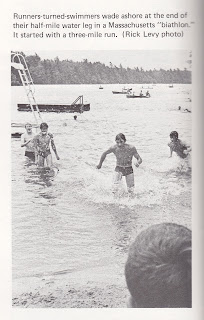I remember when I saw this picture after I got my copy and immediately thinking, "What the heck?" There is a guy running the New York City Marathon in 1972 wearing a "West Point Triathlon" t-shirt. Did the triathlon really have its origins on the east coast? I have always heard that the modern triathlon began in 1974 in Mission Bay, CA. From Wikipedia:
The first modern swim/bike/run event to be called a 'triathlon' was held at Mission Bay, San Diego, California on September 25, 1974. The race was conceived and directed by Jack Johnstone and Don Shanahan, members of the San Diego Track Club, and was sponsored by the track club. 46 participants entered this event. It was reportedly not inspired by the French events,[11] although a race the following year at Fiesta Island, San Diego, California, is sometimes called 'the first triathlon in America.'
While the first Hawaii Ironman Triathlon was held in 1978, New England (and specifically Cape Cod) also played a part in the origins of triathlon. I received this handout at the 1983 USTS triathlon in Falmouth, Ma in 1983. There were 900 triathletes in this early race and many were first time triathletes.
However, it was not Cape Cod's first triathlon. At the bottom of this early triathlon history lesson, it lists these races:
1975-An "Ironman" competition was held at Nauset Beach with the Cape Cod Lifesaving Championships. It consisted of a 1 mile run, a half mile paddle, and a 600 yard run. Aren't lifeguards supposed to swim? I would be curious to know if this was really called an Ironman race back in 1975 or if the moniker "Ironman" was just tacked on to it for this 1983 article.
1979-The first real triathlon on Cape Coe was held in Wellfleet which was the Long Pond Triathlon. It had an 8 mile bike, a 4.5 mile run, and a 1/2 mile swim.
1980-1982 saw the Cape Cod Triathlon. It seems like a low key affair (maybe among friends?) which had a 2 mile swim, a 75 mile bike, and a 20 mile run. It went from Marshfield to Provincetown. Two time winner George Missailidis would go on to be the first champion of the Cape Cod Endurance Triathlon (a full Ironman distance race) held in 1983.
In 1983, I did 3 triathlons culminating with the CCET race, and preceded by the USTS race in Falmouth and the small local Falmouth Track Club Triathlon, a race that got its start in 1981 and had already grown too big for the organizers in 1983 when 58 racers competed.
Cape Cod was a good breeding ground for the new sport of triathlon, but I was intrigued by what could have been when I saw this article in the May 1972 issue of Runners World Magazine. It seems someone had the bright idea of making a swim-run biathlon race. It appears that this race had been run for a few years prior to this, as the article mentions Amby Burfoot racing it in 1969. Now if only the race director had thought to add a biking leg, then New England would have been the birthplace of the modern triathlon.
Not only that, but the publicity machines held off on their enthusiasm until a bigger race happened a few years later in Hawaii. I really like this quote from the article:
Sports Illustrated has shown some interest in our race, and there's a chance that we can get some ink in the magazine before long. ABC's Wide World of Sports turned us down flatly (not once, but twice). But they are more Demolition Derby type, anyway.
Now what about that West Point Triathlon shirt in the 1972 New York City Marathon? The best guess as to its meaning seems to be by someone named HAIM on the Slowtwitch thread:
It probably refers to pistol shooting/swim/run triathlons that were established by the Department of the Army to promote interest in Olympic Modern Pentathlon.
Don't forget to read the article from where the photo came from in Runners World. It is about 6 women how did a sit-down protest before the 1972 marathon race. Female marathon pioneer, Nina Kuscsik was the eventual female winner. I finished side-by-side with her in one of my first road races. I think it was the 1976 version of the Falmouth Road Race. You can read the Runners World article on these female runners here.












